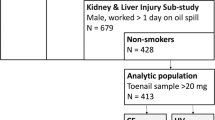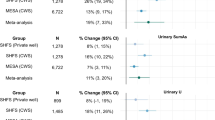Abstract
Consumption of arsenic-contaminated drinking water is associated with increased cancer risk. The relationship between arsenic body burden, such as concentrations in human toenails, and arsenic in drinking water is not fully understood. We evaluated the relationship between arsenic concentrations in drinking water and toenail clippings among a cohort of Nova Scotians. A total of 960 men and women aged 35 to 69 years provided home drinking water and toenail clipping samples. Information on water source and treatment use and covariables was collected through questionnaires. Arsenic concentrations in drinking water and toenail clippings and anthropometric indices were measured. Private drilled water wells had higher arsenic concentrations compared with other dug wells and municipal drinking water sources (P<0.001). Among participants with drinking water arsenic levels ≥1 μg/l, there was a significant relationship between drinking water and toenail arsenic concentrations (r=0.46, P<0.0001). Given similar levels of arsenic exposure from drinking water, obese individuals had significantly lower concentrations of arsenic in toenails compared with those with a normal weight. Private drilled water wells were an important source of arsenic exposure in the study population. Body weight modifies the relationship between drinking water arsenic exposure and toenail arsenic concentrations.
This is a preview of subscription content, access via your institution
Access options
Subscribe to this journal
Receive 6 print issues and online access
$259.00 per year
only $43.17 per issue
Buy this article
- Purchase on Springer Link
- Instant access to full article PDF
Prices may be subject to local taxes which are calculated during checkout

Similar content being viewed by others
References
Hughes MF, Beck BD, Chen Y, Lewis AS, Thomas DJ . Arsenic exposure and toxicology: a historical perspective. Toxicol Sci 2011; 123: 305–332.
Nordstrom DK . Public health: worldwide occurrences of arsenic in ground water. Science 2002; 296: 2143–2145.
Smith AH, Hopenhayn-Rich C, Bates MN, Goeden HM, Hertz-Picciotto I, Duggan HM et al. Cancer risks from arsenic in drinking water. Environ Health Perspect 1992; 97: 259–267.
Naujokas MF, Anderson B, Ahsan H, Aposhian HV, Graziano JH, Thompson C et al. The broad scope of health effects from chronic arsenic exposure: update on a worldwide public health problem. Environ Health Perspect 2013; 121: 295–302.
Chen CL, Hsu LI, Chiou HY, Hsueh YM, Chen SY, Wu MM et al. Ingested arsenic, cigarette smoking, and lung cancer risk. JAMA 2004; 292: 2984–2990.
Tsuda T, Babazono A, Yamamoto E, Kurumatani N, Mino Y, Ogawa T et al. Ingested arsenic and internal cancer: a historical cohort study followed for 33 Years. Am J Epidemiol 1995; 141: 198–209.
Steinmaus CM, Ferreccio C, Acevedo Romo J, Yuan Y, Cortes S, Marshall G et al. Drinking water arsenic in northern Chile: high cancer risks 40 years after exposure cessation. Cancer Epidemiol Biomarkers Prev 2013; 22: 623–630.
Beane Freeman LE, Dennis LK, Lynch CF, Thorne PS, Just CL . Toenail arsenic content and cutaneous melanoma in Iowa. Am J Epidemiol 2004; 160: 679–687.
Heck J . Lung cancer in a US population with low to moderate arsenic exposure. Environ Health Perspect 2009; 117: 1718–1723.
He K . Trace elements in nails as biomarkers in clinical research. Eur J Clin Invest 2011; 41: 98–102.
Yaemsiri S, Hou N, Slining MM, He K . Growth rate of human fingernails and toenails in healthy American young adults. J Eur Acad Dermatol Venereol 2010; 24: 420–423.
Garland M, Morris JS, Rosner BA, Stampfer MJ, Spate VL, Baskett CJ et al. Toenail trace element levels as biomarkers: reproducibility over a 6-year period. Cancer Epidemiol Biomarkers Prev 1993; 2: 493–497.
Laohaudomchok W, Lin X, Herrick RF, Fang SC, Cavallari JM, Christiani DC et al. Toenail, blood, and urine as biomarkers of manganese exposure. J Occup Environ Med 2011; 53: 506–510.
Slotnick MJ, Nriagu JO . Validity of human nails as a biomarker of arsenic and selenium exposure: a review. Environ Res 2006; 102: 125–139.
Hinwood AL, Sim MR, Jolley D, de Klerk N, Bastone EB, Gerostamoulos J et al. Hair and toenail arsenic concentrations of residents living in areas with high environmental arsenic concentrations. Environ Health Perspect 2003; 111: 187–193.
Karagas MR, Tosteson TD, Blum J, Klaue B, Weiss JE, Stannard V et al. Measurement of low levels of arsenic exposure: a comparison of water and toenail concentrations. Am J Epidemiol 2000; 152: 84–90.
Slotnick MJ, Meliker JR, AvRuskin GA, Ghosh D, Nriagu JO . Toenails as a biomarker of inorganic arsenic intake from drinking water and foods. J Toxicol Environ Health A 2007; 70: 148–158.
Chiou H-Y, Hsueh Y-M, Hsieh L-L, Hsu L-I, Hsu Y-H, Hsieh F-I et al. Arsenic methylation capacity, body retention, and null genotypes of glutathione S-transferase M1 and T1 among current arsenic-exposed residents in Taiwan. Mutat Res 1997; 386: 197–207.
Mandal BK, Ogra Y, Suzuki KT . Speciation of arsenic in human nail and hair from arsenic-affected area by HPLC-inductively coupled argon plasma mass spectrometry. Toxicol Appl Pharmacol 2011; 252: 176–182.
Tseng C-H, Huang Y-K, Huang Y-L, Chung C-J, Yang M-H, Chen C-J et al. Arsenic exposure, urinary arsenic speciation, and peripheral vascular disease in blackfoot disease-hyperendemic villages in Taiwan. Toxicol Appl Pharmacol 2005; 206: 299–308.
Lindberg A-L, Kumar R, Goessler W, Thirumaran R, Gurzau E, Koppova K et al. Metabolism of low-dose inorganic arsenic in a central European population: influence of sex and genetic polymorphisms. Environ Health Perspect 2007; 115: 1081–1086.
Gomez-Rubio P, Roberge J, Arendell L, Harris RB, O’Rourke MK, Chen Z et al. Association between body mass index and arsenic methylation efficiency in adult women from southwest U.S. and northwest Mexico. Toxicol Appl Pharmacol 2011; 252: 176–182.
Su C-T, Lin H-C, Choy C-S, Huang Y-K, Huang S-R, Hsueh Y-M . The relationship between obesity, insulin and arsenic methylation capability in Taiwan adolescents. Sci Total Environ 2012; 414: 152–158.
Beeson WL, Batech M, Schultz E, Salto L, Firek A, Deleon M et al. Comparison of body composition by bioelectrical impedance analysis and dual-energy X-ray absorptiometry in Hispanic diabetics. Int J Body Compos Res 2010; 8: 45–50.
Jebb SA, Cole TJ, Doman D, Murgatroyd PR, Prentice AM . Evaluation of the novel Tanita body-fat analyser to measure body composition by comparison with a four-compartment model. Br J Nutr 2000; 83: 115–122.
Schutz Y, Kyle UUG, Pichard C . Fat-free mass index and fat mass index percentiles in Caucasians aged 18-98 y. Int Int J Obes Relat Metab Disord 2002; 26: 953–960.
Grundy SM, Cleeman JI, Daniels SR, Donato KA, Eckel RH, Franklin BA et al. Diagnosis and management of the metabolic syndrome: an American Heart Association/National Heart, Lung, and Blood Institute Scientific Statement. Circulation 2005; 112: 2735–2752.
Ryabukhin YS . Nuclear-based methods for the analysis of trace element pollutants in human hair. J Radioanal Chem 1980; 60: 7–30.
Gault AG, Rowland HAL, Charnock JM, Wogelius RA, Gomez-Morilla I, Vong S et al. Arsenic in hair and nails of individuals exposed to arsenic-rich groundwaters in Kandal province, Cambodia. Sci Total Environ 2008; 393: 168–176.
Slotnick MJ, Meliker JR, Nriagu JO . Intra-individual variability in toenail arsenic concentrations in a Michigan population, USA. J Expos Sci Environ Epidemiol 2007; 18: 149–157.
Thomas DJ, Styblo M, Lin S . The cellular metabolism and systemic toxicity of arsenic. Toxicol Appl Pharmacol 2001; 176: 127–144.
Marchiset-Ferlay N, Savanovitch C, Sauvant-Rochat M-P . What is the best biomarker to assess arsenic exposure via drinking water? Environ Int 2012; 39: 150–171.
Ahsan H, Chen Y, Parvez F, Zablotska L, Argos M, Hussain I et al. Arsenic exposure from drinking water and risk of premalignant skin lesions in Bangladesh: baseline results from the Health Effects of Arsenic Longitudinal Study. Am J Epidemiol 2006; 163: 1138–1148.
Fatmi Z, Azam I, Ahmed F, Kazi A, Gill AB, Kadir MM et al. Health burden of skin lesions at low arsenic exposure through groundwater in Pakistan. Is river the source? Environ Res 2009; 109: 575–581.
World Health Organization. Obesity: preventing and managing the global epidemic. Report of a WHO consultation. World Health Organ Tech Rep Ser 2000; 894: 1–253.
Heck JE, Gamble MV, Chen Y, Graziano JH, Slavkovich V, Parvez F et al. Consumption of folate-related nutrients and metabolism of arsenic in Bangladesh. Am J Clin Nutr 2007; 85: 1367–1374.
Slotnick MJ, Meliker JR, Kannan S, Nriagu JO . Effects of nutritional measures on toenail arsenic concentration as a biomarker of arsenic exposure. Biomarkers 2008; 13: 451–466.
Gruber J, Karagas M, Gilbert-Diamond D, Bagley P, Zens M, Sayarath V et al. Associations between toenail arsenic concentration and dietary factors in a New Hampshire population. Nutr J 2012; 11: 45.
Van de Wiele T, Gallawa CM, Kubachka KM, Creed JT, Basta N, Dayton EA et al. Arsenic metabolism by human gut microbiota upon in vitro digestion of contaminated soils. Environ Health Perspect 2010; 118: 1004–1009.
Pinyayev TS, Kohan MJ, Herbin-Davis K, Creed JT, Thomas DJ . Preabsorptive metabolism of sodium arsenate by anaerobic microbiota of mouse cecum forms a variety of methylated and thiolated arsenicals. Chem Res Toxicol 2011; 24: 475–477.
Kubachka KM, Kohan MC, Herbin-Davis K, Creed JT, Thomas DJ . Exploring the in vitro formation of trimethylarsine sulfide from dimethylthioarsinic acid in anaerobic microflora of mouse cecum using HPLC-ICP-MS and HPLC-ESI-MS. Toxicol Appl Pharmacol 2009; 239: 137–143.
Snedeker SM, Hay AG . Do interactions between gut ecology and environmental chemicals contribute to obesity and diabetes? Environ Health Perspect 2012; 120: 332–339.
Ley RE, Turnbaugh PJ, Klein S, Gordon JI . Microbial ecology: human gut microbes associated with obesity. Nature 2006; 444: 1022–1023.
Turnbaugh PJ, Ley RE, Mahowald MA, Magrini V, Mardis ER, Gordon JI . An obesity-associated gut microbiome with increased capacity for energy harvest. Nature 2006; 444: 1027–1031.
Turnbaugh PJ, Ridaura VK, Faith JJ, Rey FE, Knight R, Gordon JI . The effect of diet on the human gut microbiome: a metagenomic analysis in humanized gnotobiotic mice. Sci Transl Med 2009; 1: 6ra14.
Nova Scotia Environment. Nova Scotia Well Logs Database. (Internet), 2009 (cited 21 February 2013). Available from http://www.gov.ns.ca/nse/groundwater/welldatabase.asp.
Acknowledgements
Production of this study has been made possible through financial support from the Canadian Partnership against Cancer and Health Canada and a grant from the Canadian Cancer Society (grant 19989). We acknowledge the support of all participants in the Atlantic PATH Project. The views expressed herein represent the views of the authors and do not necessarily represent the views of Health Canada. We thank MS Laura Nauta for producing Figure 1.
Author information
Authors and Affiliations
Corresponding author
Ethics declarations
Competing interests
The authors declare no conflict of interest.
Rights and permissions
About this article
Cite this article
Yu, Z., Dummer, T., Adams, A. et al. Relationship between drinking water and toenail arsenic concentrations among a cohort of Nova Scotians. J Expo Sci Environ Epidemiol 24, 135–144 (2014). https://doi.org/10.1038/jes.2013.88
Received:
Accepted:
Published:
Issue Date:
DOI: https://doi.org/10.1038/jes.2013.88
Keywords
This article is cited by
-
Application of fingernail samples as a biomarker for human exposure to arsenic-contaminated drinking waters
Scientific Reports (2022)
-
Factors influencing perceptions of private water quality in North America: a systematic review
Systematic Reviews (2019)



